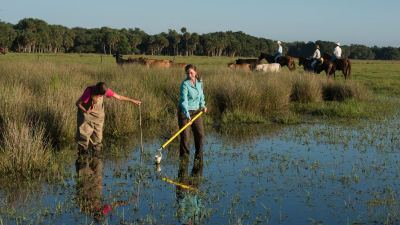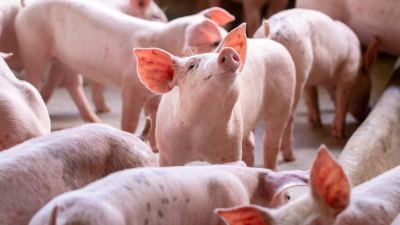John Perry: Is the pesticide industry headed toward science — or science fiction?

Major companies are taking a serious look at biopesticides as a more sustainable alternative to pesticides.
The following is an edited transcript of Tom Martin's interview with John Perry. Click below to hear the full audio:
Tom: Pesticide-free crop production: is it science or is it science fiction? Joining us to discuss this question is John Perry, agronomic services team manager with Simplot Grower Solutions. John has 40 years of experience in the pest management profession. Before joining Simplot, he had a 26-year career with Mobay/Miles/Bayer/Bayer Crop Science. Thank you for being with us, John.
John: Well, thank you for having me.
Tom: John, consumers have demanded — and received — antibiotic-free meat. Calls have also been building for pesticide-free crop production. Is that realistic?
John: I don't know that it would be realistic. We have many organic growers that utilize organically certified products. They are pesticides — even though they are organically approved — they are pesticides with various insects, diseases that we have, especially in our fruit and vegetable crops. I doubt that it's going to be totally anti-pesticide.
Tom: Just for speculation's sake, if we were to come up with a pesticide-free crop production method, what tradeoffs would that involve? What would we lose? What might we gain?
John: That's a big question. Some tradeoffs could be lower production. That would be possible. I'm not saying that that would happen, because I think we do a lot of things today that are environmentally friendly, that we're actually increasing yields with the tools that we're developing. But it's that outlier — that insect that you don't count on that plops in, or that disease shows up because of a climate difference or an introduction from outside, all of a sudden. Those are the things you can't count on.
Tom: There are a lot of variables out there.
John: Exactly, a lot of variables.
Tom: We've heard predictions that the global biopesticide market is going to double within the next five years. What are biopesticides? And, if you agree with those predictions, what's driving that growth?
John: There are several things. I agree with that statement; I think it's going to grow faster, and there are several reasons. One is the regulatory realm. Government agencies have some of the harsher chemicals — the harsher pesticides — with the bullseye on it. They go about it in various manners. Reducing the crops that are registered on it is one method that they use.
Even more importantly, the big companies — the major companies, like the Bayers of the world — they are looking at these products for a couple of reasons. One is sustainability. It will be a sustainable product for their company, but also, the cost of bringing those biological products to the marketplace is much lower than the traditional pesticide. Today, it's about $300 million to bring a new insecticide, fungicide or herbicide to the marketplace. With the biopesticide, it could be only $25 million. There's a huge cost difference. And then, of course, you have the acceptance by the regulatory organizations too.
Tom: We're operating under twin imperatives these days: one, growing food to meet demand and feed the world, and also, grow it in ways that make it as safe as possible for human consumption. These were often in conflict. Are we getting any closer to figuring out a way to make them work in harmony?
John: That's a tough one, because we deal with specialty crops in California and in a lot of our acres, and we also have issues that we deal with at the same time. Acres are being reduced because of housing, especially in our coastal areas. For 80 to 100 years, we have been growing our key vegetables crops, our fresh market crop — those that you buy in the store. Then, the acres that we have available to us, because of that 80- to 100-year realm, we have diseases that have established themselves that are identified with those crops. They like to feed on those crops. We have those kinds of issues.
The biggest issue is the competition for water in California. It's estimated that, in 2020, we're going to have 40 million as a population base. Ninety percent of that population is in four key population areas; agriculture is not one of them. Agriculture is going to take not even a second-tier position, maybe a third-tier position, because you have water for people, water for environmental reasons and, then, water for agriculture. Water is going to be the driver for us more than anything else. We have to become more efficient in how we use it. The crops that we have need to be of high value so that we can afford that water, because it's going to have a higher cost to agriculture. Yeah, water is the driver, and that's what I see in the future.
Tom: Do those drought conditions — and there have been a lot of drought conditions — do they impact the crop from a pest perspective? In other words, do they weaken the crop's ability to fight off pests?
John: It's more of the opposite. If we have a wet year, then we will have larger population of insects, diseases or weeds than a drought year, per se. During drought years, it's more about having enough water to grow the crops to stay sustainable in the marketplace, because you have an infrastructure that you have to deal with also.
If you have a cannery or several canneries that are running at a certain capacity, and you don't have the crop for that cannery — take tomatoes, for example — then all that infrastructure is impacted. Then you have labor; that's the other side. If you are not growing the crops and you have a certain labor pool, if you're not there, they're going to move on to where they can earn a living. It is pretty complicated. I guess I'm going in a roundabout way of answering your question, but drought probably has less effect on pests than a wetter year. During wetter years, yes, we can have that impact.
Tom: You have to stay on top of trends in the science, in the marketing, in the conditions on the ground, in the pesticide realm. Are there certain trends that you are following right now that are particularly important?
John: Yes. Soil-borne diseases are going to be more of a problem because of our irrigation practices — with low-pressure irrigation drip or micro-sprinklers, it seems to exacerbate the problem. At the same time, our growers, because of the cost of doing business — and they are trying to extract the most money they can out of that crop as soon as possible. With almonds, it takes four to five years for full production; pistachios, eight to nine years; walnuts, seven to eight years. The growers are pushing them really hard, so they are really pushing those trees to grow quicker. They want to crop earlier, that type of thing.
That puts pressure on the root system. Our goal as a company, in the last three or four years now, is to really focus on the root system — to get the healthiest root system we can. That means overcoming diseases, overcoming salt conditions in the soil that we bring with our irrigation water that we're pulling up from down deep. It's not always the best water. We have all those parameters that we have to deal with, but that to be as productive as possible on less acres. That's what happens. That's what you have to do. You have to have a good, strong root system to overcome those problems.
Tom: John Perry is agronomic services team manager with Simplot Grower Solutions. We thank you for being with us, John.
John: Thank you for having me.
I would like to learn more about sustainable crop solutions!















